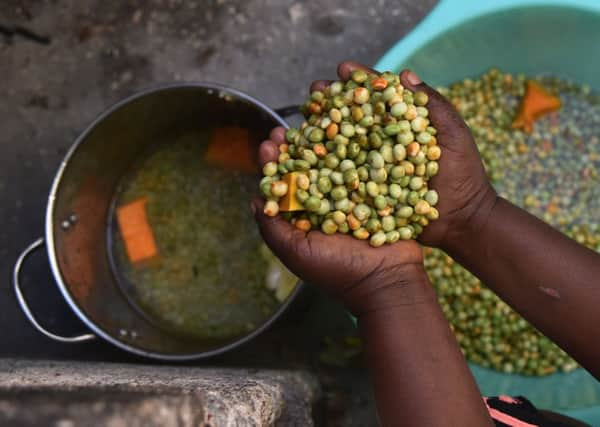It’s time to think differently about our diet, writes Pete Iannetta


While many consumers have found themselves passive recipients at the end of the supply chain, increasing numbers are questioning the food they consume and the values which surround food production and consumption.
Consumers’ concerns relate to nutritional value, food safety, authenticity and provenance, use of agrochemicals and antibiotics, and their collective ecological impacts. The current global agri-food system appears to be locked into a trajectory that may not be sustainable.
Advertisement
Hide AdAdvertisement
Hide AdNonetheless, Scottish agri-food systems are responding to public apprehensions, and the emerging food culture shows that consumers can be instrumental in shaping new policies and business developments, such as those being examined under the Scottish Government’s Good Food Nation initiative.
To help ensure efforts are targeted effectively, sound evidence is essential. Agriculture accounts for 25 per cent of total global greenhouse gas (GHG) emissions – the largest share after energy and transport.
The production of animals for meat and the application of synthetic nitrogen fertiliser are the largest contributors to agriculture’s GHGs budget.
In fact, the contribution of cattle to methane emissions, about 20 per cent of the global total, is one of the better-known quantities in GHG accounting, and atmospheric methane is the second biggest contributor to climate change.
Of all agricultural activities, meat production – rather than synthetic fertiliser use – receives the bulk of such scrutiny, and the meat-supply chain now faces serious competition from plant-based alternatives.
Consumers’ interest in these new plant-based products is no passing fad, especially as the taste and texture qualities of vegetarian convenience foods improve to meet consumer expectations: the plant-based food market is projected to have annual growth of around 4.7 per cent a year, from a 2018 baseline of $4.6 billion.
Products like the Beyond Meat burger also have powerful scientific evidence behind them, and this is used as a powerful marketing tool. An upwards shift in the economics also brings the power to direct political decision-making – the Slow Food movement’s phrase “eating is a political act” has never been truer.
Evidence of consumers’ interest in transitioning towards more sustainable diets is not difficult to come by, and terms like “flexitarianism” and “demitarianism” have emerged as commonplace, their popularity bolstered by annual campaigns such as “Veganuary”.
Advertisement
Hide AdAdvertisement
Hide AdAllied to this, the portfolio of internationally recognised certification programs for specific foodstuffs, such as gluten free, is set to be extended to include plant-based certification.
Scientific data regarding the potential impact of such dietary shifts at a global level also appear clear: plant-based diets can lower the environmental impact of agriculture, although ovo-lacto-vegetarian appears to be only slightly less impactful that a vegan dietary choice. People can only grow what their local weather and soil conditions allow, however, and in some areas that may be extensively raised livestock. Whatever the future holds for agri-food systems, sustainable economic development will demand greater cooperation between industry, lobby groups and consumers.
Changing what we grow can make as big a difference as adjusting what we eat. Legume crops such as beans and clover are a sustainable source of highly nutritious food and feed.
Rather than needing fertiliser (usually an artificial input) they make it. They convert atmospheric nitrogen into biologically useful nitrogen so can help lower the GHG footprint of agriculture. They may also help enable nutritional security, countering undernutrition and unbalanced nutrition which result in increased health care costs.
Ironically, Scotland misses out on these potential benefits because, like most of Europe, the vast bulk (circa 80 per cent) of our legume protein is imported. Even more ironically, this legume protein usually arrives as soybean for use as animal feed, often GM sourced from ex-rainforest regions in South America. Currently, legumes occupy only 1 to 4 per cent of European farmed land, and 1 per cent of the arable area in Scotland.
In other words, there’s a massive opportunity to create more sustainable agri-food systems based on legumes grown here.
This was recently acknowledged by a European Commission report, and some countries (Germany, for one) have also developed national plant protein plans. In Scotland, new capacities and services must be developed if a sustainable, legume-based agri-food-future is to become a reality. A few things need to happen for us to take this opportunity: we need to expand and enhance current legume-based cropping systems and agricultural practices, including introducing new legume species; build capacity in the supply-chain for legume processing; generate new high-value markets… and we need to educate the public education on the wider benefits of legumes.
Pietro (Pete) Iannetta is based at the James Hutton Institute in Dundee. Pete leads research on Scottish Government funded legume-based agri-food systems and is involved in EU-funded research projects TRUE, DIVERSify and TomRes. www.hutton.ac.uk